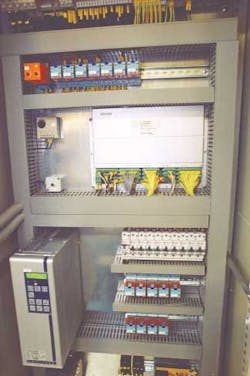Vibration monitoring system cuts breakdown risk for gas turbines up to 10 MW
Flexible system for power generation, pumping
NIRA's vibration monitoring satellite (VMS) can trigger emer-gency shut down of turbines after detecting potentially damaging vibration levels. Once the trigger is activated, the turbine shuts down before damage occurs within the unit. This is critical in offshore settings where secondary power sources are not often available. If the problem is caught early enough, preventive measures can be taken.
The VMS, the newest part of the company's NIRA Industrial Control System (NICS), went to the market earlier this year after recent testing with Volvo Aero.
"We have learned a lot with this application," said Mats Tobiasson, application engineer. "Measuring the vibrations is quite complicated."
null
The semi-tailored system focuses on core turbine engine control. Several turbine packages can be used with the NIRA equipment for power generation or pumping applications.
"Our approach is to be somewhere in between the wholly dedicated and the programmable logic controller (PLC) system," he said. "This system is more flexible. You can add on satellites for different purposes."
NICS can also be used with a PLC system.
The VMS tracks the various vibrations in the area where the turbine operates. It can filter out rpm vibrations. By narrowing down the tracked vibrations, the unit is able to watch the pertinent vibration levels and signal an emergency shut down if the values reach certain set points. One system is used for each turbine.
null
"With our solutions, even small-scale gas turbines out in the operational field can be equipped with an advanced and cost-effective vibration analysis system, which reduces the risk of breakdowns and extends the machine's economical lifetime," said Peter Lagerkvist, NIRA technical manager of control systems.
Price breakthrough
The NICS is composed of a main control unit (MCU). Other units, such as the digital signal processor satellite (DSPS), temperature monitoring satellite (TMS), and the new VMS can be added for extra functionality. The DSPS and VMS units can also be used as standalone control systems.
"An independent standalone solution and a complete system from NIRA both represent an important price/performance breakthrough," Lagerkvist said.
The MCU offers analog and digital signals and communications links. It communicates with the satellites via control area network (CAN) or Ethernet interfaces. The MCU has a redundant hardware safety module for shutdown.
The TMS has four temperature inputs. It can be placed atop the MCU or at any location within the CAN bus range. The VMS has three vibration sensors and can handle accelerometers and different kinds of transmitters. It is designed to control turbines in the power range up to 10 MW, and can be supplied as original equipment from the manufacturer or added as an upgrade. The compact system is constructed for tough environments and can work in temperatures reaching 70° C.
The DSPS is for calculation-intensive applications. It communicates with the MCU via the ethernet connection. NIRA recommends using this unit in more complicated applications. The associated WinNAP application is used for commissioning and allows download of software to the system, changes parameters for variables, and handles data collection.
"It's an area where there's been a lack of solutions that are less expensive for small- and medium-sized turbines," Tobiasson said.
For more information, contact Katarina Edgren-Marsh, Nira. Tel: +46 31 734 21 10; fax: +46 31 734 21 01; [email protected]; www.niraautomotive.com.


